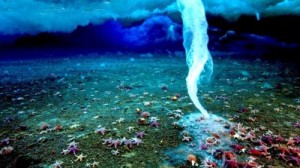You’ve been baking under the sun for a few weeks now. There’s more to come. Summer feels like an energy leech, sucking away your strength, your enthusiasm, your life force. You long for winter. So it’s time to remind everyone that cold, though attractive right now, can be as terrifying and lethal as fire. To reinforce this message, we’re breaking out the Icy Finger of Death.
This amazing footage was shot by the BBC using time-lapse photography and shown as part of the Discovery Channel’s Frozen Planet series. It reveals the never-before-seen formation and deadly aftermath of a brine icicle (or brinicle), which “plunges toward the seabed from the Antarctic ice shelf above, freezing marine invertebrates in its path and killing everything it touches.”
That’s the description accompanying the video. The image is actually more, well, chilling.
Science corner from the BBC:
HOW DOES A BRINICLE FORM?
Freezing sea water doesn’t make ice like the stuff you grow in your freezer. Instead of a solid dense lump, it is more like a seawater-soaked sponge with a tiny network of brine channels within it.
In winter, the air temperature above the sea ice can be below -20C, whereas the sea water is only about -1.9C. Heat flows from the warmer sea up to the very cold air, forming new ice from the bottom. The salt in this newly formed ice is concentrated and pushed into the brine channels. And because it is very cold and salty, it is denser than the water beneath.
The result is the brine sinks in a descending plume. But as this extremely cold brine leaves the sea ice, it freezes the relatively fresh seawater it comes in contact with. This forms a fragile tube of ice around the descending plume, which grows into what has been called a brinicle.
Brinicles are found in both the Arctic and the Antarctic, but it has to be relatively calm for them to grow as long as the ones the Frozen Planet team observed.










